The Neighborhood Story Project (NSP) enables Tennessee residents to research and share the histories – and have a voice in the future – of the places they call home. Nine communities across Tennessee have completed a NSP since 2017. See below to learn more about each project.
If you are interested in bringing this program to your community, please contact Melissa Davis, Director of Grants & Public Programs, at melissa@humtn.org. Our next project training occurs in October 2022. Click HERE for details on how your community may apply.
North End, Pulaski Cleveland Park, Nashville
Jay Bird Hill, Jefferson City Edgehill, Nashville
Hopetown, Lewisburg Stratford, Nashville
Weakley Co., Martin McKinney Center, Jonesborough
Blythe Oldfield Neighborhood, Cleveland
Pulaski: “North End Story Project” 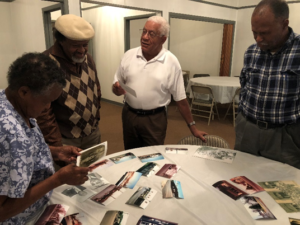
Wolf Gap Education Outreach, Inc.
The Pulaski team focused their project on Pulaski’s historically black neighborhood, known as the North End. Six community members joined the project, all of whom are African Americans with ties to the North End. Concerned that the perspectives of North End residents were not always sought out or listened to by city leaders, and eager to inform their upcoming local elections, the group gathered information about resident’s concerns and hopes for their neighborhood through 52 surveys and 13 interviews. They also collected a number of historic artifacts related to the North End. They shared their findings at a town hall meeting and dinner attended by more than 50 residents, a number of city officials, as well as political candidates. Since then, the City has increased communication with and investments in the North End, and members of the Story Project have stayed involved in local government. One member was recently appointed to county commissioner, and is committed to providing advocacy and voice for the neighborhood.
The project gives you a sense of where you can go… it helps me to better focus on what needs to be done, how it should be done, and how to get people involved.
~ Georgia, Pulaski Team Member
Jefferson City: “Jay Bird Hill Story Project from the African American Perspective”
Mossy Creek Foundation
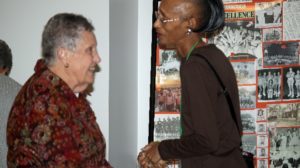 The Jefferson City facilitation team partnered with two local churches that are central to the black community. With their help, the facilitators recruited a team of twelve participants, who were primarily African American elders with longstanding ties to the area. The team focused on the history of Nelson Mary School and the Jay Bird Hill neighborhood, a historically black school and community, asking, “How has the neighborhood changed since we were children?” To explore this, the team recorded and transcribed 36 oral histories. Excerpts from the interviews, along with historic images and other artifacts, were displayed at a community-wide exhibition attended by more than 100 residents, and covered in two newspaper articles.
The Jefferson City facilitation team partnered with two local churches that are central to the black community. With their help, the facilitators recruited a team of twelve participants, who were primarily African American elders with longstanding ties to the area. The team focused on the history of Nelson Mary School and the Jay Bird Hill neighborhood, a historically black school and community, asking, “How has the neighborhood changed since we were children?” To explore this, the team recorded and transcribed 36 oral histories. Excerpts from the interviews, along with historic images and other artifacts, were displayed at a community-wide exhibition attended by more than 100 residents, and covered in two newspaper articles.
The interviews are now archived both at the local library—which until this project had no archives, and no designated section for local African-American history—and at Carson-Newman University. The group presented their work to the Jefferson County Historical Society, and remains committed to continuing their efforts to preserve the area’s African American history.
We wanted the story of African-American experience there in Jay Bird Hill told. ~ Roverta, Jefferson City Team Member
Lewisburg: “HOPETown Story Project”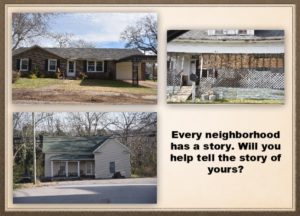
Marshall County Memorial Library
The Lewisburg facilitation team focused on the downtown neighborhood, an area that has experienced years of decline as businesses closed, jobs left, and many rental units have been poorly maintained. The team partnered with HOPEtown, an interdenominational community center and social service provider in the area, and recruited four participants with ties to the downtown neighborhood and a shared concern for the way the downtown neighborhood and its residents are stigmatized. The group wanted to know, what can we do to improve the quality of life here? To explore this question, the team videotaped more than 20 interviews with neighbors.
Martin: “Weakley County Training School Storytellers”
Paul Meek Library, UT at Martin
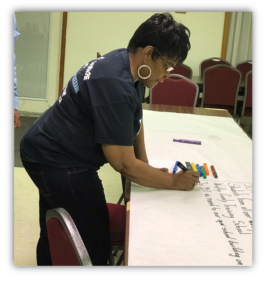 The Martin Story Project explored the Weakley County Training School, which opened as a school for African American students in 1923 and operated until 1969. Partnering with the United Methodist Church and the school’s alumni association, the facilitators recruited a core group of nine participants, all older African American residents with ties to the school. The team hoped to document what the Weakley County Training School had meant to students, families and the local black community. They gathered archival data related to the school, video-recorded 12 interviews with alumni, and launched a website to share their history (weakleycotrainingschool.org.) The project culminated with a local celebration, and the team plans to add to the collection of interviews at the annual homecoming event each August. In July, 2019, Martin City Board approved selling the property of the school to the alumni association for $1, and plans are underway to turn it into a museum to honor the school’s legacy in the community.
The Martin Story Project explored the Weakley County Training School, which opened as a school for African American students in 1923 and operated until 1969. Partnering with the United Methodist Church and the school’s alumni association, the facilitators recruited a core group of nine participants, all older African American residents with ties to the school. The team hoped to document what the Weakley County Training School had meant to students, families and the local black community. They gathered archival data related to the school, video-recorded 12 interviews with alumni, and launched a website to share their history (weakleycotrainingschool.org.) The project culminated with a local celebration, and the team plans to add to the collection of interviews at the annual homecoming event each August. In July, 2019, Martin City Board approved selling the property of the school to the alumni association for $1, and plans are underway to turn it into a museum to honor the school’s legacy in the community.
Well, I guess selfishly I just wanted them to know our own personal family history. But it’s more than that, it’s the history of a town. It’s the history of a community. It’s the history of West Tennessee. And it is a story that’s not recorded in any history book. ~Johnny, Martin Team Member
Cleveland Park Story Project
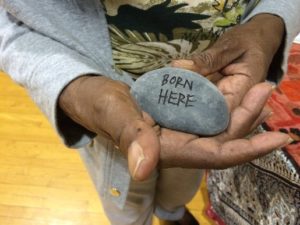
Cleveland Park is an East Nashville neighborhood that’s history as a Black enclave dates back to some of the first Black neighborhoods established after the end of the Civil War. Today, the neighborhood demographics are rapidly changing. Cleveland Park, which was more than 75% Black in 1970—and was comprised of 90% Black households between 1990 and 2000—is now rapidly losing Black residents. According to the U.S. Census, between 2000 and 2010, Black residents decreased by 18%. Within Cleveland Park, tensions have arisen along race and class lines, as residents of different tenures recall different pasts, experience different presents and imagine different futures for their neighborhood.
As their research questions, the group asked: What holds Cleveland Park together, and how can we make Cleveland Park home again? Members interviewed and took pictures of their neighbors, gathered historic and contemporary images, as well as archival materials. The culminating project was an interactive community exhibition where neighbors could see images of their neighbors, hear voices of the neighborhood, and add to a timeline of the neighborhoods past and imagined future. People were encouraged to write a word on a stone to take home, signifying what they wanted to remember about their neighborhood. A simple video of neighborhood images and voices can be found here.
Edgehill Story Project
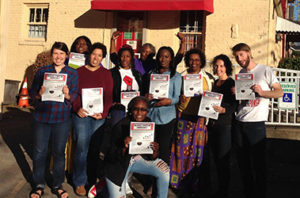
The southeast Nashville neighborhood of Edgehill has many similarities to Cleveland Park. Its growth as a robust Black neighborhood can also be traced to the Civil War. Urban renewal was particularly devastating to Edgehill, separating a previously unified neighborhood by two major freeways, cutting-off the once robust commercial area on 12th Ave, and razing the homes of more than 2000 people to build public housing. For years, Edgehill has faced encroachment from Belmont and Vanderbilt Universities, as well as Music Row. Proximal to downtown, between 2002 and 2016, housing costs went up 135%, and—in a neighborhood that was nearly 90% Black from the 1970s through the 1990s–between 2000 and 2010 the number of Black households decreased by 68%.
Concerned about the vulnerability of their neighbors, the Edgehill Story Project asked: What is driving development and the displacement of our neighbors, and how can we intervene? Members collected and analyzed data from on housing values, foreclosures, evictions, and demographic changes. They created a comic book to explain how zoning works and how community members can get involved. And, drawing on video interviews they collected with neighbors, they made a video that can be used as an educational and organizing tool.
They pulled much of the data gathered, as well as resources for renters and homeowners, into a report, that was distributed at a culminating community event. Attended by more than 80 people, the event was a call to action, and many members of the team have continued organizing their neighbors against displacement. The report and film can be found here.
Stratford Story Project
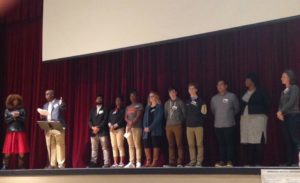
Located in East Nashville, Stratford High School draws from two long-time Black neighborhoods—including the largest public housing project in Nashville—as well as a cluster of historically white, and affluent, neighborhoods. Opened as an all-white school in the 1960s, the school has weathered years of challenges related to court-ordered desegregation, white flight, disinvestment, and high staff turnover, and the struggles of students to succeed in school.
In recent years, Stratford has had more than $20 million in renovations and begun distinguishing itself as a STEM school. Concurrent to the transformations within the school, the surrounding neighborhood is also changing, and the Stratford zone is now one of the most desirable places to live in Nashville.
The Stratford Story Project asked: How has the changing reputation of Stratford impacted people’s investment in the school, and how can we change it for the better?
Members collected interviews from students and teachers from every decade of the school’s history, along with archival data, ultimately weaving these together into a feature-length documentary film. At an early showing to more than 100 people, the team gathered feedback regarding perspectives that were missing. The team conducted a second round of interviews, and the final film is now available here.
Jonesborough Story Project
McKinney Center
The Jonesborough team focused their project on a contested piece of land that a white American Revolutionary War veteran, Loyd Ford, willed to his five Black children, who he owned as slaves. The will also guaranteed these children their freedom at the time of his death. Following his death in 1843, Ford’s white children contested the will, which went before the Tennessee Supreme Court twice – ultimately the Supreme Court held that the will was legal, and the formerly enslaved persons were emancipated and gained legal ownership of the land in 1850. The land was later lost, under suspicious circumstances, and is once again owned by white descendants of the Ford family.
The facilitators recruited a team of nine community members, four Black and five white. The team focused on the research question(s), “who gets to call this place home?” They conducted robust archival research (including researching court records, property records, and historic newspapers) as well as informal interviews to learn about the Black Ford children willed the land, and their journey. The team used their research to apply for a state-recognized historic marker, to be installed October 2022, that emphasizes the Black Ford descendants as agents of their own liberation who fought for their freedom and land.
Cleveland: “Blythe Oldfield Neighborhood Story Project”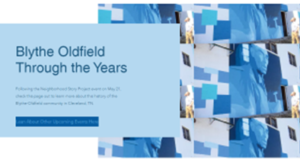
The Cleveland facilitation team partnered with two local organizations working in the Blythe-Oldfield Neighborhood, City Fields—a local CDC—and the Blythe Oldfield Community Association. The focus of the project was the Blythe-Oldfield neighborhood, a historically white, working class area that has experienced disinvestment and diminishing social cohesion. The area is undergoing a variety of changes, including a shifting demographic as a growing number of Latino families have moved into the neighborhood, and the imminent redevelopment of a former factory in the area, which some are concerned will lead to gentrification, leading to a loss of affordable housing and continued disruption to social ties.
Facilitators recruited a core team of four participants, with four additional community members contributing to and consulting on the project. The guiding question for this team was, “What is the story of neighborhood connectivity in BlytheOldfield?” To explore this, the team recorded 20 interviews with neighbors; collected pictures from residents and archival research; and conducted informal interviews with other neighbors. The material gathered was used to inform “A Celebration of Our History,” an interactive community event on May 21, 2022.


